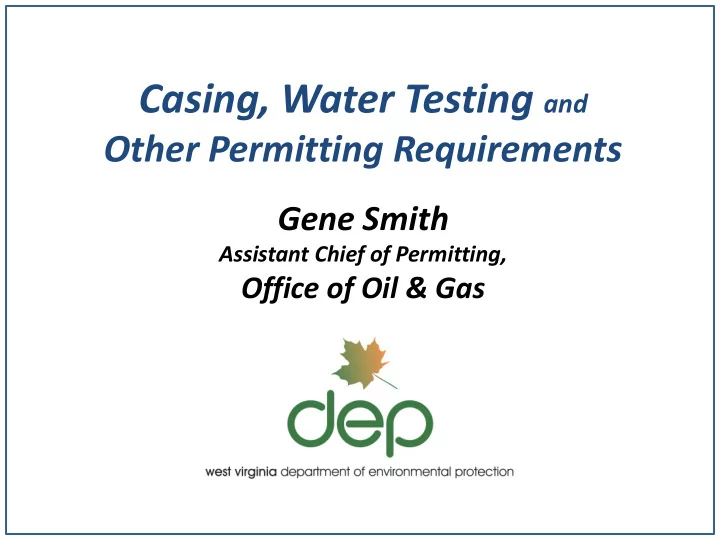

Casing, Water Testing and Other Permitting Requirements Gene Smith Assistant Chief of Permitting, Office of Oil & Gas
What does Sea Level / Elevation mean? How to calculate elevations? Mean sea level (MSL) is a measure of the average height of the ocean's surface (such as the halfway point between the mean high tide and the mean low tide); used as a standard in reckoning land elevation. The elevation of any geographic location or a specific point within the length of a wellbore is its height compared to a fixed reference point, in this case, the MSL.
Freshwater Casing Standards for all wells From 35-4-11.3 “In no case shall the freshwater casing penetrate salt water or gas bearing strata or extend below elevation”
Freshwater Casing: Conventional Wells From § 35-4-11.3 • Extend at least 30’ below deepest freshwater horizon • Cement circulated to surface • If the coal protection casing is cemented to the surface it may also be considered a fresh water protective casing.
Freshwater Casing : Horizontal Wells From Casing Standards rev. 12/10/12 • Extend at least 50’ and no more than 150’ below deepest freshwater horizon • Cement circulated to surface • Minimum of 300’ of freshwater casing Less can be installed to avoid penetrating saltwater, • oil, or gas-bearing zones • May be installed >150’ below deepest freshwater to cover workable coal seams (20” or more)
Coal Protection Casing: Conventional and Horizontal Wells From § 22-6-18 and § 22-6A-5(a)(10) “ When a well penetrates one or more workable coal beds, a string of casing shall be run in the hole to a point at least 30’ below the lowest workable coal bed penetrated and shall be circulated and cemented to surface ” From Casing Standards rev. 12/10/12 Either freshwater casing or the intermediate casing may serve as the coal protection casing
Water Sampling: Conventional Wells Notice shall be given to surface owner of the right to request the operator sample • and analyze a well or spring. (§ 35-4-19.2.a) 19.2.a) Notice shall be given prior to filing permit application. (§ 35-4-19.2.d) 4-19.2.d) • Permit application shall list users identified and how they were noticed • (ie personal service, posting notice at dwelling, mailing, etc). (§ 35-4-19.2.e) (35-4- 19.2.e) At the request of surface owner, operator shall sample and analyze water from any • wells or springs located within 1000’ of proposed well. (§ 35-4-19.1.a) (35-4-19.1.a) If no request is made, operator shall select, sample, and analyze from any one well or • spring within 1000’. (§ 35-4-19.1.b) (35-4-19.1.b) Chief may require sampling to 2000’. (§ 35-4-19.1.c) 35-4-19.1.c) • Operator may sample & analyze any or all water wells or springs within 1000’. (§ 35- • 4-19.1.d) 5-4-19.1.d)
Water Sampling: Conventional & Horizontal Wells Parameters (§ 35-4-19.3) pH (35-4-19.3) • Iron • Total Dissolved Solids • Chloride • Detergents (MBAS) • Must use lab approved by the Chief (§ 35-4-19.3.d) • (list provided on OOG website) Total coliform and dissolved methane (OOG recommended) • Any other parameter determined by the operator • Distribution of Results Operator shall, no later than 30 days after receipt of such analysis, provide results to the Chief and any of the users who requested it.
Water Sampling: Horizontal Wells Notice is to be given to any surface owner or water purveyor who is known to the applicant to have a water well, spring, or water supply source located within 1500’ of the center of the well pad, and the opportunity for testing their water well shall be given. (§ 22-6A-10(d) 6A-10(d)) Registering of all water supply wells drilled & operated by the operator. All drinking water wells within 1500’ of the water supply well shall be flow and quality tested . (§ 22-6A-8(g)(5)(D)) (( 22
Rebuttable Presumption Drilling was the cause of communication or deprivation of the fresh water source. (§ 22-6- 35 and § 22-6A-18(b))
To Rebut Presumption To rebut under § 22-6A-18(c), must prove one of the following: • Pollution existed prior to drilling • Refused to allow sampling • Water supply not within 1500’ of the well • Pollution occurred more then 6 months after drilling • Pollution occurred because of something other than drilling
Replacing Water Supply Operator shall replace water supply where the secretary determines contamination, diminution, or interruption. (§ 22-6A-18(e)and (f)) Secretary may order such things as: • Provide drinking water within 24 hrs • Provide temporary supply within 72 hrs • Provide permanent supply within 2 years
Requirements for Permit Applications Water Well Owner Information Show water well owner names/addresses on the map of water wells next to • their well. All water well owners within specified distance whether 1000’, 1500’, 2000’ • etc. must be noticed regardless of the condition of their well. Certified Mail Receipts Attach a specifically-labeled certified mail receipt to each notice. • Make sure name/address on notice form matches mail receipt. • Fees For H6A applications, do not send an extra $100 pit fee. • Send $10,150 for first well, $5,150 for subsequent wells on the pad. • Cover Letter Send a cover letter describing proposed well work with every permit • application and every modification.
More Requirements for Permit Applications 6A1 Lease Information Put lease names and/or numbers on the plat that correspond to names and/or numbers on the 6A. Form Updates Check our Horizontal Well Permit Packet Application Page • regularly to obtain updated versions of our application forms. Per our updated checklist, put the water well map right behind the • 6A. Plat Information on plat needs to match exactly all other forms in • application. Be consistent with well name, surface owners, and all info on the • plat.
Checking Application Status Go to: https://apps.dep.wv.gov/oog/permitsearch_new.cfm Search to find out: API# of your app Activities Completed Please use the API# of your application whenever you call OOG to request information.
What questions do you have? Gene Smith 304-926-0499 x1652 Gene.C.Smith@wv.gov
Recommend
More recommend